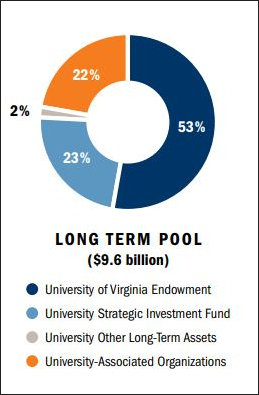The University of Virginia’s long-term investment pool has reached an all-time high of $9.6 billion, according to the University of Virginia Investment Management Company (UVIMCO). The university also maintains a $475 million short-term pool, invested in short-term Treasury bills and notes.
The long-term investment pool includes the UVa endowment, the Strategic Investment Fund and other long-term assets. In 2019, the pool generated an investment return of 5.8%, somewhat below it’s 7.9% benchmark. But over a 10-year period, UVIMCO has generated an 11.0% return compared to a 9.2% benchmark.
According to the Cavalier Daily student newspaper, UVa uses about 5% of the money returned on its investments for scholarships, fellowships and professorships, about $238 million in 2019.
While 80% of the endowment portion of the investment pool is restricted by the terms of the donors’ gifts, the balance is used “to meet emerging needs and highest strategic priorities.” Those priorities, as defined by the University’s current capital campaign, are funding scholarships, lectureships, research funds and book funds. States the report:
Most recently, the Foundation responded to the University’s need once again by helping to attract to UVA exceptional classroom teachers and innovative researchers through its Professorship Program. A series of $5 million endowed professorships has enabled the Foundation to underscore its commitment to attracting top talent by providing the University the resources it needs to hire outstanding faculty. In less than ten years, the Foundation has raised more than $55 million in support of its professorships—or eleven $5 million endowed funds.
In 2019, investments from the Strategic Investment Fund (SIF) have gone to the Biocomplexity Institute, the Memorial for Enslaved Laborers, and the Bicentennial Scholars Fund.
— JAB


Leave a Reply
You must be logged in to post a comment.